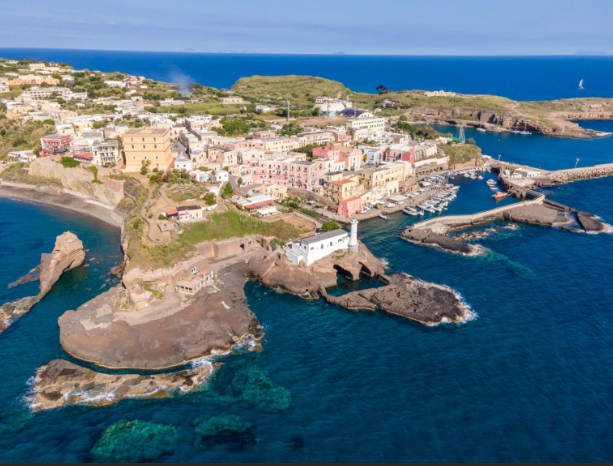
OPTIMIZING RENEWABLE ENERGY INTEGRATION IN VENTOTENE, ITALY
Overview
First known as Pandataria, Ventotene Island is, with Santo Stefano Island, the eastern part of the Pontinian archipelago which also comprehends Ponza, Palmarola, and Zannone. The island, 33 km far from Cape Circeo, has a maximum altitude of 139 m above sea level and a surface of 1,247 km2. From the demographic point of view, the island’s population varies from a maximum of 4,350 people in August to a minimum of 580 people in November, mainly due to the tourist vocation of the island and to the commuter residents. From the power generation viewpoint, Ventotene is not connected to the national grid. The energy production is provided by six diesel generators, respectively, a primary system, with a total peak power of 1.6 MW, and a backup system, with two diesel generators (total peak power of 500 kVA). The scenario analysis for Ventotene followed the PRISMI methodology, starting with the island's current energy situation as a baseline. A 2030 scenario (RES) aimed for 50% renewable energy penetration, while the HighRes scenario targeted 100% RES, addressing grid stability challenges. Both scenarios included increasing transport electrification, with smart charging in RES and Vehicle-To-Grid (V2G) in HighRes. Most renewable integration relies on rooftop photovoltaics (1.3 MW for RES, 2 MW for HighRes), as ground-mounted installations are prohibited due to the island's nature reserve status. Additionally, a biomass plant offers a space-efficient alternative, leveraging Ventotene’s agricultural sector to utilize waste for energy production and fertilizer.a)
b)
Figure 1 Monthly representation of technologies contributing to the power supply in a) RES and b) HighRES scenario
The HighRES scenario is 35% more expensive than the RES scenario but also brings significant benefits in terms of employment and decarbonization. The largest expenditure is on electric vehicles (EVs), but this limits the need for additional storage to 2 MWh. In the HighRES scenario, V2G enables an increase in PV capacity without expanding battery storage, improving grid flexibility while controlling CEEP. Investment costs for transitioning from the current system to the RES scenario are similar to those for moving from RES to HighRES. Despite high costs, EVs benefit from strong incentives and fast payback, supported by NRRP funding for green islands. The installation of 1.2 MW of PV could create a small maintenance team (2–3 people), reducing the high costs of outsourced maintenance. A biomass plant could repurpose diesel plant jobs while generating additional employment in agricultural waste collection and fertilizer distribution.
Macro objective:
- Demonstrate the feasible integrated energy system for an insular community, based 100% on locally available renewable energy sources
Specific objectives:
- Use locally available renewable energy
- Decarbonize sectors of energy demand
- Provide socio-economically sound options for the development of an insular community
- CO2 emissions reduced by 7.2 kt per year
- New RES generation units installed: 3 MW of Solar PV and 0.4 MW of biomass
- Facilitate local employment on RES projects: 3 jobs in RES installations and maintenance
Antun Pfeifer

1. The National Recovery and Resilience Plan (PNRR)- provides EU-funded financial support to member states for post- pandemic economic recovery, reforms, and sustainable growth.


